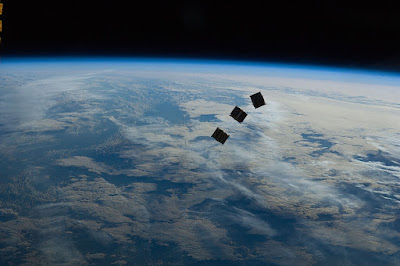 |
| Small satellites. |
A convergence of AI, micro-miniaturization, 3D printing, relatively inexpensive space launches, and thruster-on-a-chip technology will herald a new age of space exploration by corporations and governments alike.
Think about all the things your smart phone can do. Now imagine a smart phone without a screen. All those thousands of emails are not clogging the system. The dozens of apps are gone, including the ones you actually use. Instead, there is a resident AI that sifts through all the sensors and comms, constantly evaluating status of the mission; whether to shut down and coast, make course corrections, or send in a status report to a remote user interface. It is the captain of a twenty pound drone headed to an asteroid to check it out for precious metals, water, and other valuables.
Micro-electro-mechanical system (MEMS) sensors and manipulators will augment the electronic circuits and software on this drone. MEMS gyroscopes and accelerometers power tiny GPS systems for cars and missiles. MEMS piezoelectronics allow inkjet printers to work properly. MEMS microphones populate mobile phones and autos. Silicon MEMS pressure sensors tell us the pressure in our tires and our bodies. There are tiny fluid pumps, ultrasound transducers, and scanners. Soon, all of these devices will become nano-electro-mechanical systems (NEMS), much smaller and requiring less energy. These devices will be incorporated into this new wave of robotic space drones along with new applications such as drilling into asteroids, ore assayer, and atmospheric analyzers.
 |
| MEMS rheostat, about 500 microns in diameter. |
Rocket Lab is turning satellite launching on its head by making smaller rockets that can launch more often and cheaper. It uses 3D printing to print out its rocket motors. It can print out one every 24 hours. It uses composite materials and electric fuel pumps to make the Electron rocket lean and efficient. The goal is to launch a 150 - 225 kg payload into space weekly. Soon, it will be carrying small, autonomous space vehicles to explore for asteroid treasure and do scientific surveys of planets and moons.
 |
| Electron rocket from Rocket Lab. |
Once in orbit, these autonomous drones will need motive power to accomplish their missions, and this is where Accion Systems’ thruster-on-a-chip technology takes over. This is a new type of ion energy drive using an electrospray process to accelerate ions out of a specialized computer chip, creating thrust. It will do this as long as it has the ionic liquid propellant it needs; a non-toxic, non-flammable salt solution. It currently has a thrust density of 0.4 Newtons per meter squared with a theoretical limit of 10,000 Newtons per meter squared.
 |
| Thruster chip from Accion Systems. |
With eight planets, 172 moons, a 150 million asteroids in the asteroid belt, 100 million icy objects in the Kuiper Belt, and an estimated one to ten trillion objects in the Oort Cloud, there are a lot of things in our Solar System to be investigated. Many of these things will have to wait on a small, long-lasting nuclear power systems to get to them, but nuclear fusion is only 30 years away (as it has been for the last 70 years).
Asteroid mining will become to corporations what the California and Klondike gold rushes were to individuals. Dire news about peak this and peak that competing with stories of weather gone crazy and new warm temperature records every day will be further goads to looking off planet for energy and material resources. Some corporation will soon realize that a new gold rush is upon us.
That corporation, which may currently be someone sitting around reading an online article right now, will begin making robot drones like Apple makes iPhones. You can buy a basic drone and then get accessories like location beacons to leave on asteroids, software to make a run at skimming the atmosphere of some large moon, storage for the return of ore samples, a small shielded capsule for Earth re-entry, or any number of useful and expensive iterations.
It’s not something that can be done on the back of a napkin - maybe lots of napkins - but, given the progression of technology, major parts of it could be off-the-shelf. Currently, the largest piece of the puzzle is the AI software to carry out the mission from Earth orbit to, say, the asteroid Ryugu, take samples, and make it back.
The target product is a 20 pound drone that can go 50 million miles somewhere in space, do a survey, and come back. The Electron rocket is ready to take five at a time every week to their rendezvous with destiny. Need a napkin?

No comments:
Post a Comment